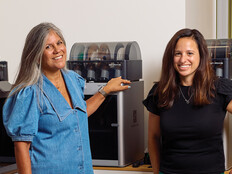Schools Must Support Educators While Keeping Tabs on Tech Trends
Modern learning environments seamlessly integrate technology into spaces that are designed around teaching and learning, giving instructors and students the tools they need to succeed in a physical setting that promotes collaboration and supports multiple learning styles. While connected devices are an important part of modern learning environments, audiovisual equipment and even classroom furniture are also essential to creating spaces that are conducive to teaching that focuses on future-ready skills.
A modern learning environment requires more than just investments in physical assets. Although the concept of the modern learning environment is still emerging, a consensus is already forming around best practices, which include a commitment to student-centered learning and professional development for educators.
Getting Teachers on Board with IT
No matter what investments school districts make to create a modern learning environment, they likely won’t have much impact if teachers don’t use them. According to a 2017 study by Blackboard and Project Tomorrow, a majority of school principals (51 percent) and technology leaders (67 percent) say that the greatest challenge they face in implementing digital learning or expanding technology use is motivating teachers to change their traditional instructional practices. And, while 71 percent of district administrators say that the effective use of technology is “extremely important” for student success, only 43 percent of classroom teachers say the same.
To change teacher attitudes, school and district leaders must show instructors how technology can benefit their practice and provide them with resources that set them up for success. The Blackboard and Project Tomorrow study identifies five essential elements that teachers need to effectively and efficiently integrate digital content, tools and resources into daily instruction in their classroom: planning time to work with colleagues, a classroom set of devices for student use, readily available tech support, professional development and reliable internet.
Leaders should also follow key trends to be prepared for what's coming next.
Ed Tech to Keep an Eye On in the Next Five Years
In their K–12 2017 Horizon report, the New Media Consortium and the CoSN predict that these technologies will have a significant impact on classrooms within the next five years
One Year Or Less
- Makerspaces — These spaces, where students use tools such as 3D printers, laser cutters and animation software, are emerging as a vehicle to expose students to technical disciplines and encourage creative and entrepreneurial thinking.
- Robotics — Educators are leveraging robotics to promote critical and computational thinking, and to provide hands-on learning in STEM subjects.
Two to Three Years
- Analytics — As schools work with and interpret Big Data, they will develop improved ways to make targeted decisions that will enhance student learning and assist at-risk students.
- Virtual Reality — VR headsets and applications will help educators transport students to distant geographical locations and give them up-close views of scientific phenomena ranging from hurricanes to the circulatory system.
Four to Five Years
- Artificial Intelligence — AI has the potential to provide insights into teaching and learning, and to relieve teachers of tedious tasks.
- Internet of Things — IoT technologies are already helping schools operate their facilities more efficiently. Over time, they will also help educators better understand how certain actions can impact student achievement.
For more information on the benefits of modernizing the classroom, take a look at the CDW whitepaper, "A Modern Learning Environment."








